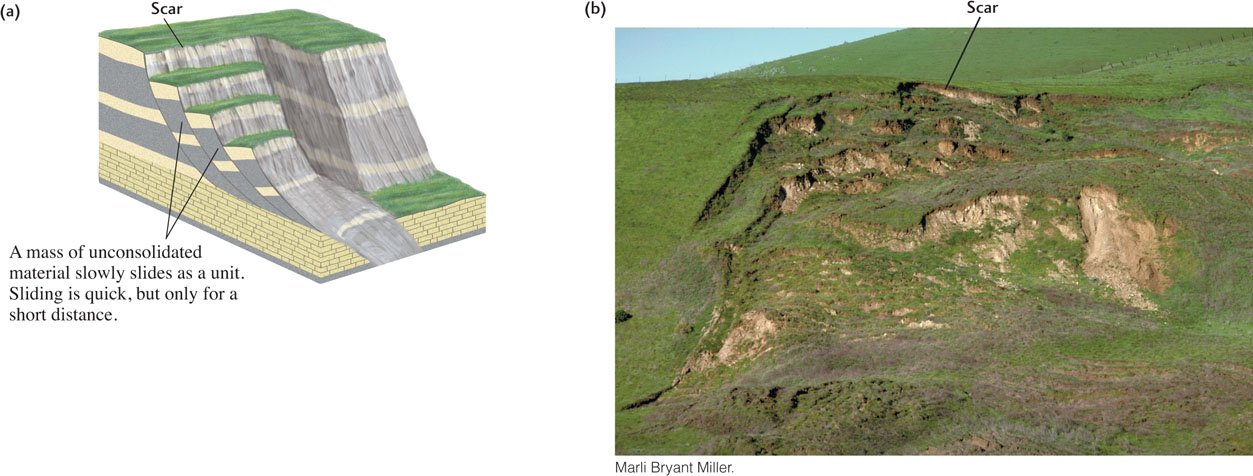Classification of Mass Movements
Although the popular press often refers to any mass movement as a “landslide,” there are many different kinds of mass movements, each with its own characteristics. In this textbook, we use the term landslide only in its popular sense, to refer to mass movements in general.
Geologists classify mass movements in accordance with three characteristics, as summarized in Figure 16.17:
- 1. The nature of the moving material (for example, whether it is rock or unconsolidated material)
- 2. The velocity of the movement (from a few centimeters per year to many kilometers per hour)
- 3. The nature of the movement: whether it is sliding (the bulk of the material moves more or less as a unit) or flowing (the material moves as if it were a fluid)
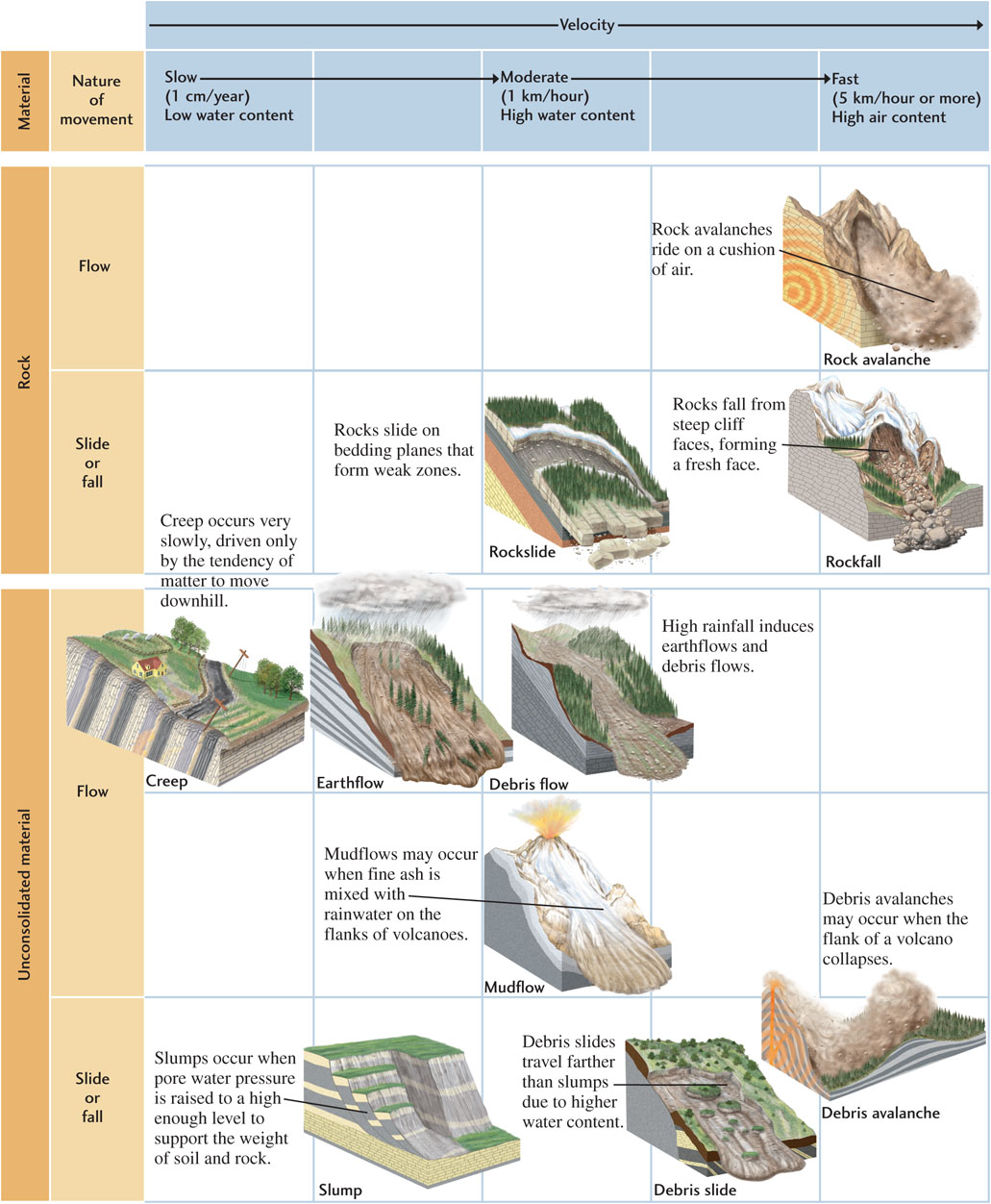
The nature and velocity of the movement are greatly influenced by the water or air content of the moving material.
Some movements have characteristics that are intermediate between sliding and flowing. Most of the mass may move by sliding, for example, but parts of it along the base may move as a fluid. A movement is called a flow if that is the main type of motion. It is not always easy to tell the exact nature of a mass movement, however; the only evidence may be the debris deposited after the movement is over.
454
455
Mass Movements of Rock
Rock movements include rockfalls, rockslides, and rock avalanches. These movements may involve small blocks or larger masses of bedrock. During a rockfall, newly detached individual blocks of rock plummet suddenly in free fall from a cliff or steep mountainside (Figure 16.18). Weathering weakens bedrock along joints until the slightest pressure—often exerted by frost wedging—is enough to trigger a rockfall. The velocities of rockfalls are the fastest of all rock movements, but the travel distances are the shortest, generally only meters to hundreds of meters. Evidence for the origin of rockfalls is clear in the blocks seen in the accumulation of talus at the foot of a steep bedrock cliff, which can be matched with rock outcrops on the cliff. Talus accumulates slowly, building up into blocky slopes along the base of a cliff over long periods.
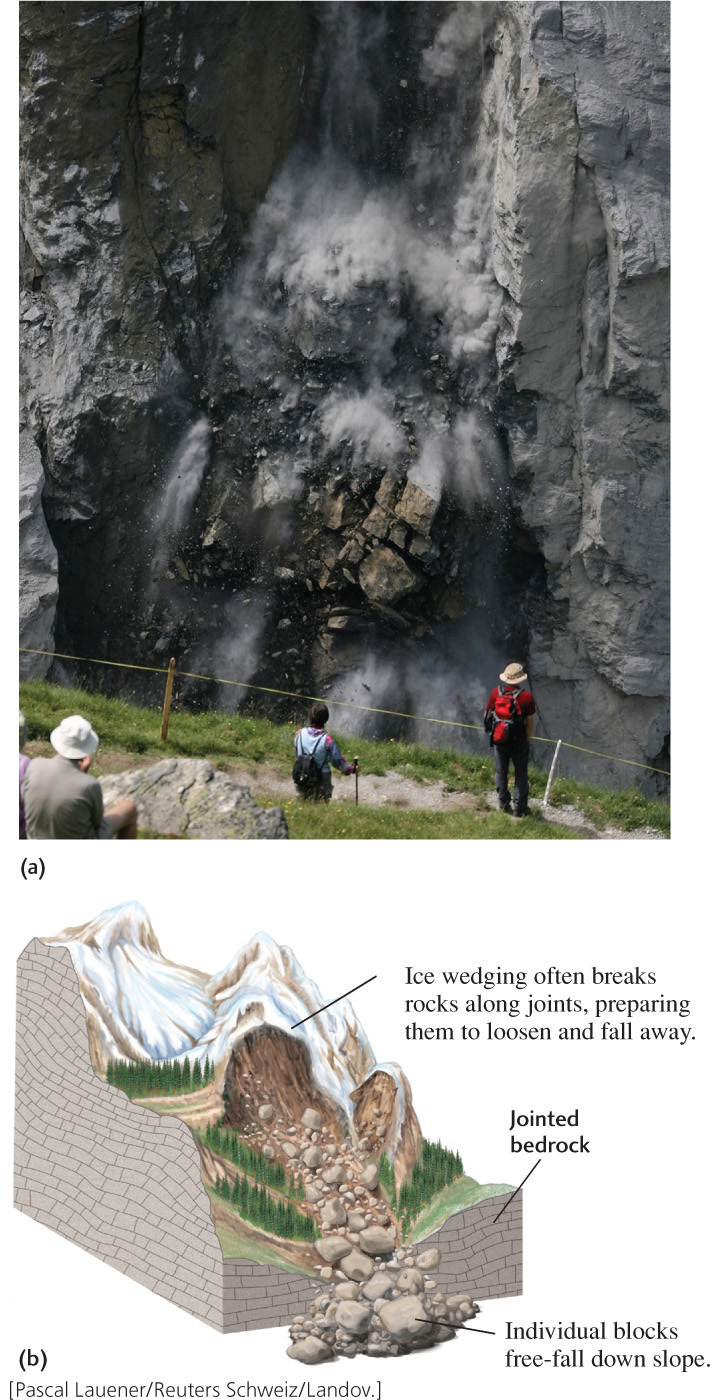
In rockslides, rocks do not fall freely, but rather slide down a slope. Although these movements are fast, they are slower than rockfalls because masses of bedrock slide more or less as a unit, often along downward-sloping bedding or joint planes (Figure 16.19).
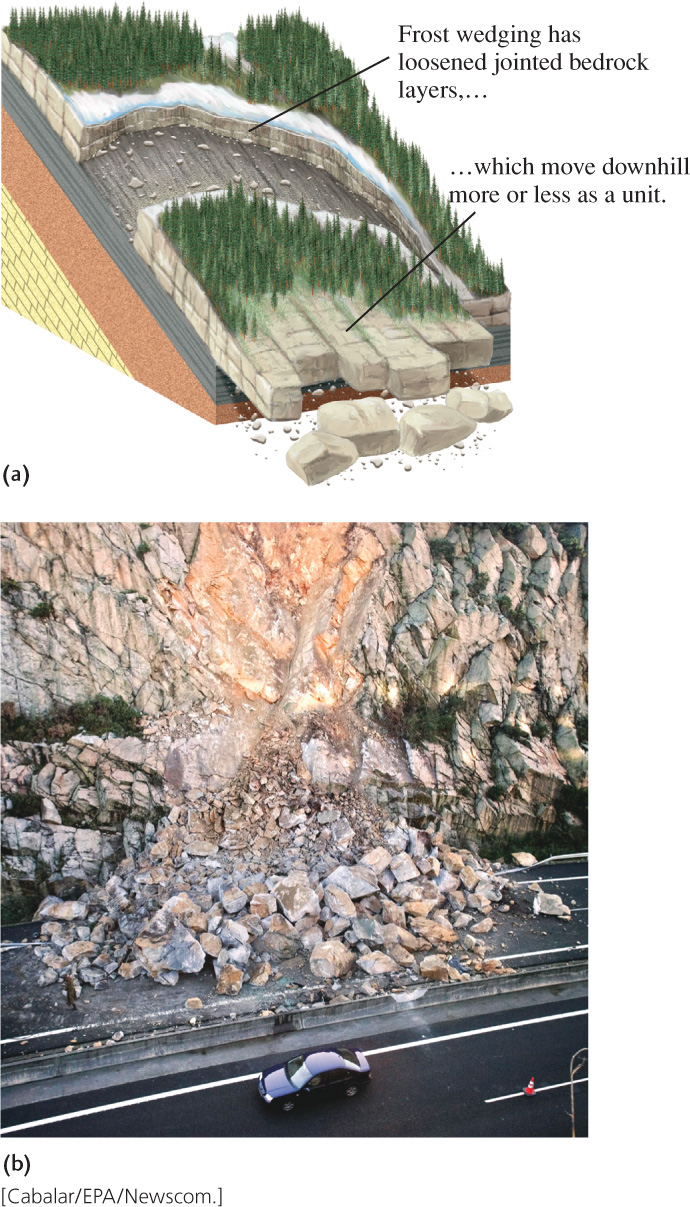
456
Rock avalanches differ from rockslides in their much greater velocities and travel distances (Figure 16.20). They are composed of large masses of rocky material that break up into smaller pieces when they fall or slide. The pieces then flow farther downhill at velocities of tens to hundreds of kilometers per hour, riding on a cushion of air. Rock avalanches are typically triggered by earthquakes. They are some of the most destructive mass movements because of their large volume (many contain more than a half million cubic meters of material) and their capacity to transport materials for thousands of meters at high velocities.

Most rock mass movements occur in high mountainous regions; they are rare in low hilly areas. Rock masses tend to move where weathering fragments rocks already predisposed to breakage by deformation features such as faults and joints, relatively weak bedding planes, or foliation. In many such regions, extensive talus accumulations have been built by infrequent but large-scale rockfalls and rockslides.
Mass Movements of Unconsolidated Material
Mass movements of unconsolidated material include various mixtures of sand, silt, clay, soil, and fragmented bedrock, as well as trees and shrubs and materials of human construction, from fences to cars and houses. Most mass movements of unconsolidated materials are slower than most rock movements, largely because of the lower slope angles at which these materials become unstable. Although some unconsolidated materials move as coherent units, many flow like very viscous fluids. (Viscosity, as you will recall from Chapter 4, is a measure of a fluid’s resistance to flow.)
The slowest type of unconsolidated mass movement is creep: the gradual downhill movement of soil or other debris (Figure 16.21). Rates of creep range from about 1 to 10 mm/year, depending on the soil type, the climate, the steepness of the slope, and the density of the vegetation. The movement is a very slow deformation of the soil, with the upper layers of soil moving down the slope faster than the lower layers. Such slow movements may cause trees, telephone poles, and fences to lean or move slightly downslope. The weight of the masses of soil creeping downhill can break poorly supported retaining walls and crack the walls and foundations of buildings. In icy regions where the deeper layers of soil are permanently frozen, a type of creep called solifluction occurs when water in the surface layers of soil alternately freezes and thaws, causing the soil to ooze downhill, carrying broken rocks and other debris with it.
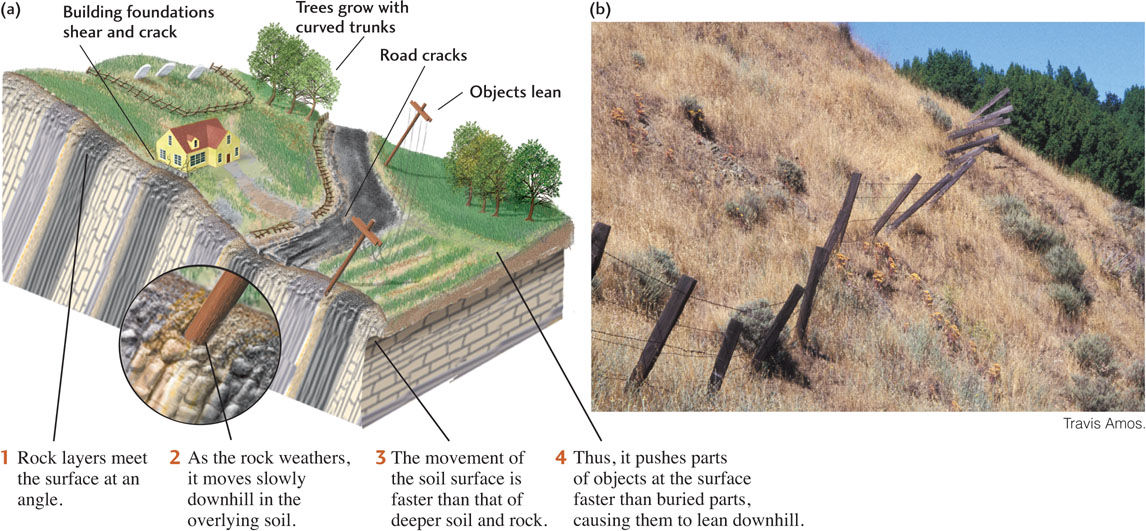
Earthflows and debris flows are fluid mass movements that occur when rainfall soaks and loosens permeable material overlying a layer of less permeable rock. They usually travel faster than creep, as much as a few kilometers per hour, primarily because the moving materials are saturated with water and thus have little resistance to flow. An earthflow is a fluid mass movement of relatively fine grained materials, such as soils, weathered shales, and clay (Figure 16.22). A debris flow is a fluid mass movement of rock fragments supported by a muddy matrix (Figure 16.23). Debris flows are made up mostly of material coarser than sand and tend to move more rapidly than earthflows. The slide at Laguna Beach, California, described above, was classified as a debris flow. In some cases, debris flows may reach velocities of 100 km/hour.
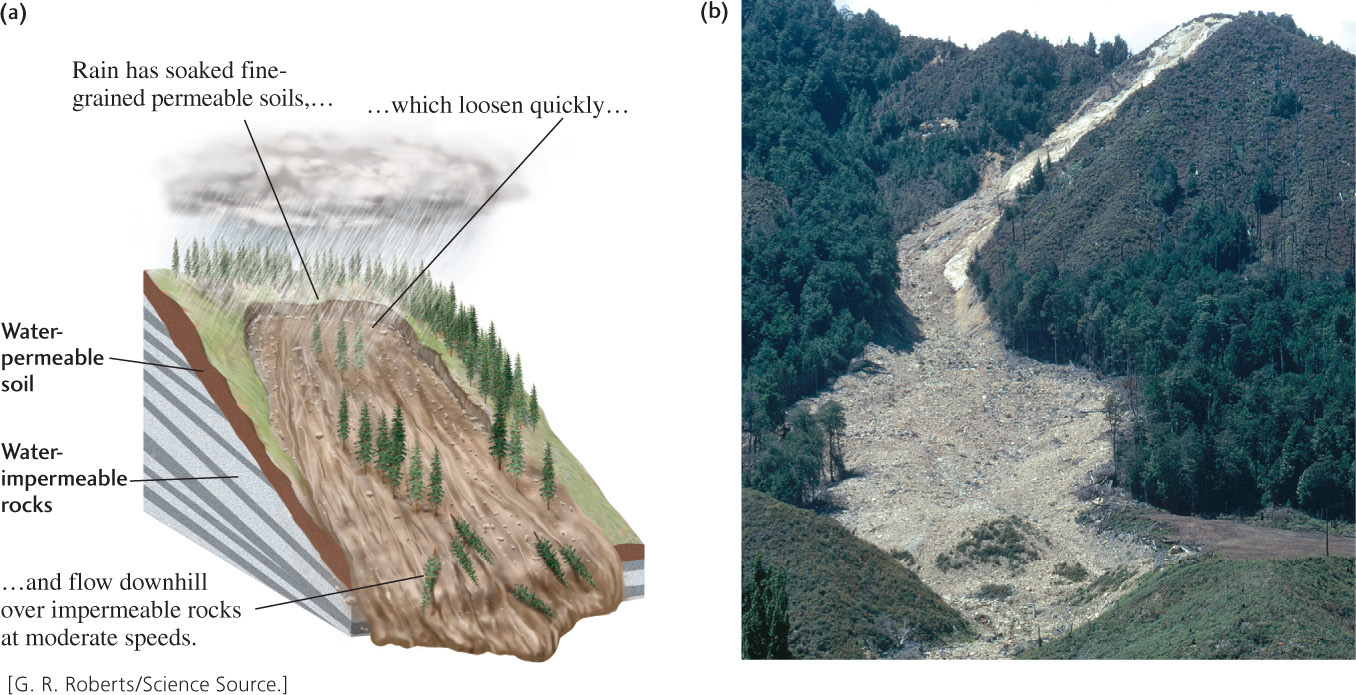
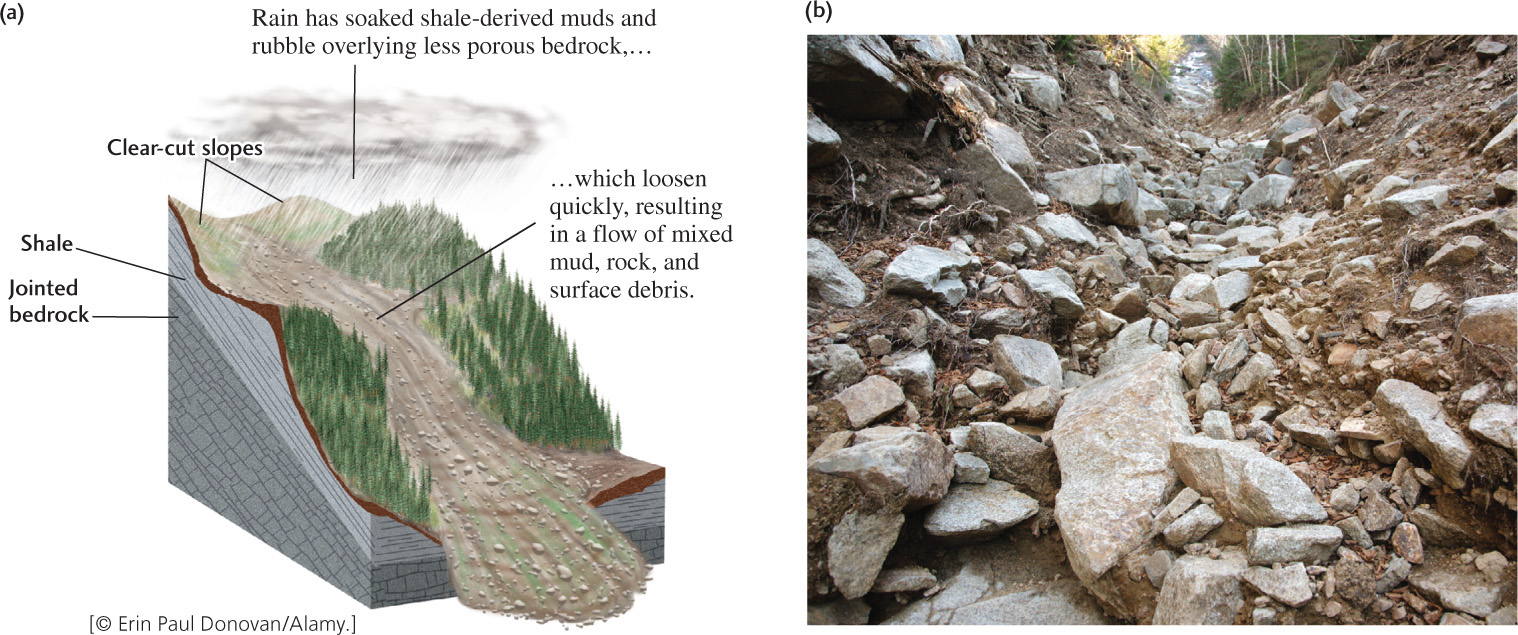
457
Mudflows are flowing masses made up mostly of material finer than sand, along with some rock debris, and containing large amounts of water (Figure 16.24). The mud offers little resistance to flow because of its high water content and thus tends to move faster than earth or debris. Many mudflows move at several kilometers per hour. Most common in hilly and semiarid regions, mudflows occur when fine-grained material becomes saturated. Mudflows of wet pyroclastic material, called lahars, may be triggered by volcanic eruptions, as when a lava flow melts snow and ice (see Chapter 12). Similarly, mudflows may start when dry, cracked mud on a slope is subjected to infrequent, sometimes prolonged, rains. If the mud keeps absorbing water as the rain continues, its physical properties change: its internal friction decreases, and the mass becomes much less resistant to movement. The slope, which is stable when dry, becomes unstable, and any disturbance, such as an earthquake, triggers movement of waterlogged masses of mud. Mudflows may travel down tributary valleys on upper slopes and merge on the main valley floor. Where mudflows exit from confined upper valleys into broader, lower valley slopes and flats, they may splay out to cover large areas with wet debris. Mudflows can carry huge boulders, trees, and even houses.

458
459
Debris avalanches (Figure 16.25) are fast downhill movements of soil and rock that usually occur in humid mountainous regions. Their speed results from the combination of high water content and steep slopes. Water-saturated debris may move as fast as 70 km/hour, a speed comparable to that of water flowing down a moderately steep slope. A debris avalanche carries with it everything in its path.
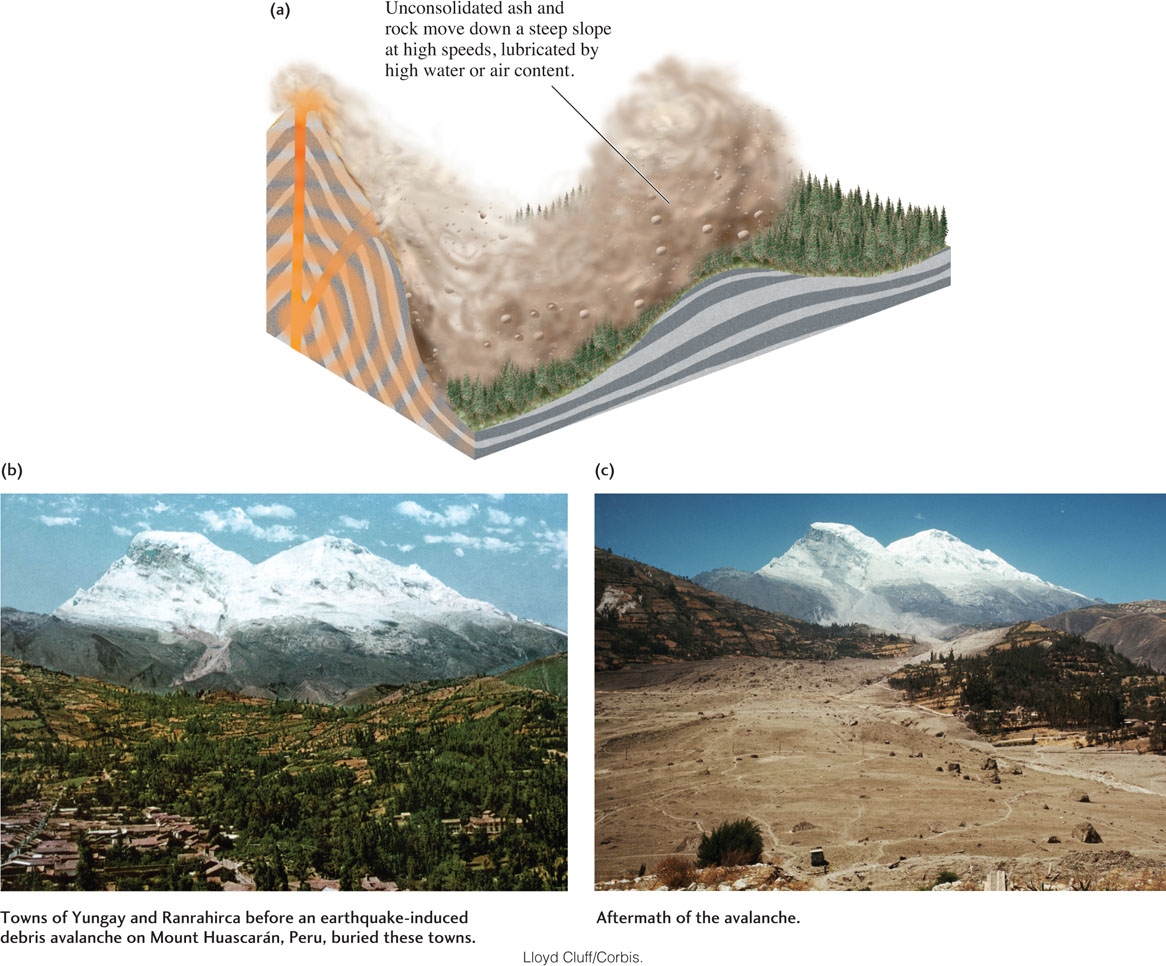
In 1962, a debris avalanche on Nevado de Huascarán, Peru, one of the highest mountains in the Andes, traveled almost 15 km in about 7 minutes, engulfing most of eight towns and killing 3500 people. Eight years later, on May 31, 1970, an earthquake toppled a large mass of glacial ice at the top of the same mountain. As the ice broke up, it mixed with the debris of the high slopes and became an ice-debris avalanche. The avalanche picked up additional debris as it raced downhill, increasing its speed to an almost unbelievable 280 km/hour. Up to 50 million cubic meters of muddy debris roared down into the valleys, killing 18,000 people and wiping out scores of villages (Figure 16.25b). On May 30, 1990, an earthquake shook another mountainous area in northern Peru, in the same active subduction zone, again setting off mudflows and debris avalanches. It was the day before a memorial ceremony scheduled to commemorate the disaster that had occurred 20 years earlier. In regions close to convergent plate boundaries, where uplift and volcanism build up unstable slopes and earthquakes are frequent, there can be no doubt about the necessity of learning how to predict both earthquakes and the dangerous mass movements that follow.
460
In a slump, a mass of unconsolidated material slides slowly downslope as a unit, leaving a scar at its source (Figure 16.26). In most places, the slump slips along a basal surface that forms a concave-upward shape, like a spoon. Faster than slumps are debris slides (Figure 16.27), in which rock material and soil move largely as one or more units along planes of weakness, such as a waterlogged clay zone either within or at the base of the debris. During the slide, some of the debris may behave as a chaotic, jumbled flow. Such a slide may become predominantly a flow as it moves rapidly downhill and most of the material mixes as if it were a fluid.
